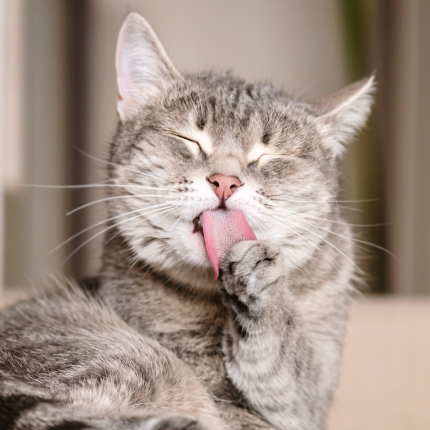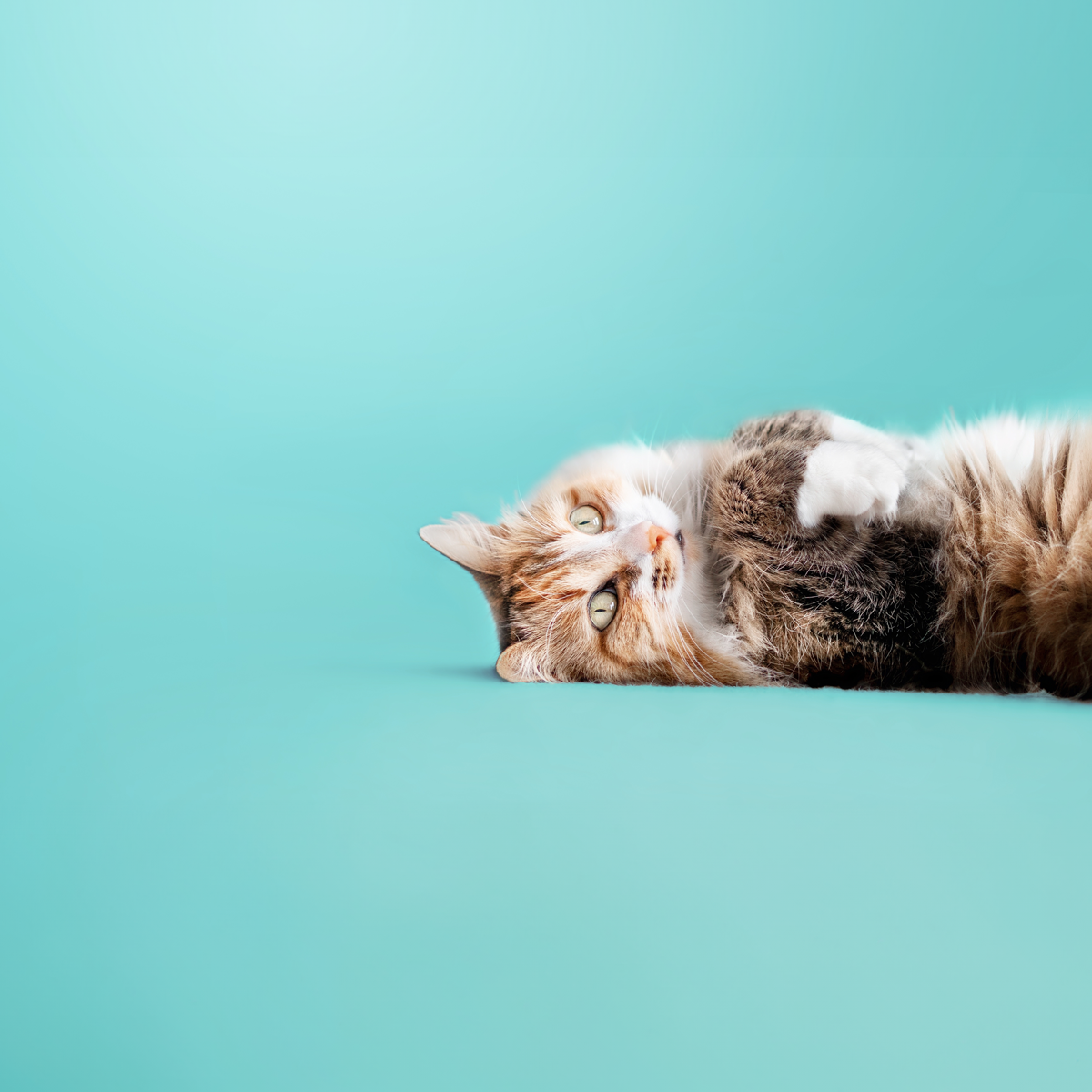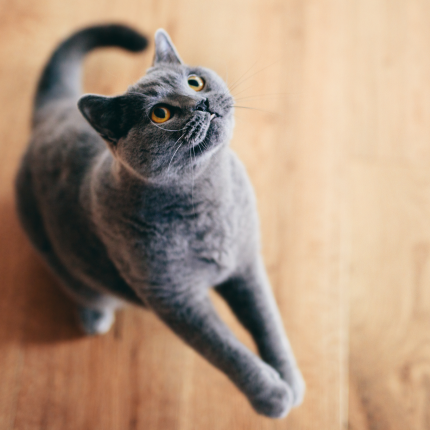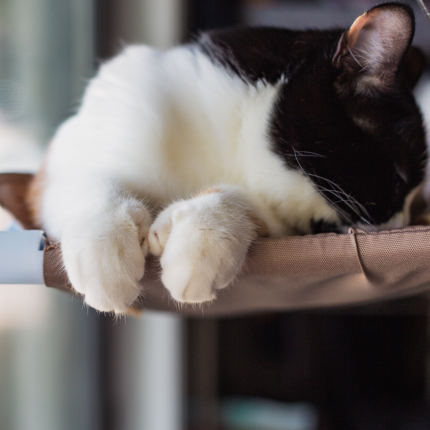What Is Overgrooming?

Grooming is a normal behavior in cats that helps keep their coats clean, free of dirt, and in good condition. It also provides them with comfort, as grooming triggers the release of endorphins, chemicals that promote relaxation and well-being. However, when grooming becomes excessive, it can lead to bald patches, irritated skin, and other health issues.
Overgrooming is often easy to spot, as you may notice thin or patchy areas in the fur, particularly around the back, belly, and legs. In extreme cases, a cat may develop completely bald spots. The hair that remains might be rough, brittle, and uneven, indicating that the cat is pulling or chewing on the fur rather than the hair falling out naturally.
[infolinks_inarticle]
Why Do Cats Overgroom?
There are several reasons why a cat might overgroom. The most common causes include skin diseases, pain, or stress. Let’s dive into each of these in more detail:
1. Skin Diseases
One of the leading causes of overgrooming in cats is skin disease. Cats may groom excessively in response to itching, which is typically caused by parasites such as fleas, mites, or allergies. A flea infestation, for example, can cause severe itching, especially in flea-allergic cats, who may overgroom in an attempt to relieve the discomfort. Skin infections or fungal issues can also cause excessive grooming as a form of self-soothing.
When skin disease is the culprit, the grooming behavior is often a response to itching or discomfort. Flea-infested cats tend to groom more around their lower body (where fleas are most likely to be found), whereas cats with environmental or food allergies might overgroom anywhere on their bodies.
2. Pain or Discomfort
Pain can also cause overgrooming, particularly if it’s affecting your cat’s joints or urinary system. Older cats suffering from osteoarthritis, for example, might groom excessively around their painful joints to alleviate discomfort. Similarly, cats with bladder issues, such as cystitis, may focus their grooming behavior on their lower abdomen.
3. Stress or Anxiety
Overgrooming can also be a result of stress, anxiety, or frustration; this is often referred to as “psychogenic alopecia.” Cats are sensitive to changes in their environment, and even small shifts like a new family member, renovations, or a change in their routine can lead to anxiety. Cats may resort to grooming as a coping mechanism, as it provides comfort and helps alleviate feelings of stress.
4. Behavioral Issues
In some cases, cats may develop compulsive behaviors, including overgrooming, due to underlying psychological factors. These are often linked to a lack of stimulation or an inability to express natural behaviors in their environment.
[google_adsense_horizontal]
When to Seek Help
If your cat’s grooming behavior seems excessive, it’s important to consult with your veterinarian to determine the cause. Some common signs that you should seek veterinary advice include:
- Hair loss or bald patches
- Skin irritation, redness, or scabbing
- Frequent grooming, especially in specific areas like the belly or hindquarters
- Changes in behavior, such as increased anxiety or changes in appetite or activity levels
A veterinarian will begin by taking a thorough medical history and performing a physical exam. If necessary, they may recommend diagnostic tests such as blood tests, skin scrapings, or urinalysis to rule out underlying health conditions.
Treatment for Overgrooming
The treatment for overgrooming will depend on the cause of the behavior. Some common treatments include:
1. Flea and Parasite Control
If fleas or other parasites are identified as the cause, your veterinarian will recommend an effective flea treatment. Prescription flea medications (POM-V) are often more effective than over-the-counter products, so make sure to follow your vet’s advice. It’s important to treat all animals in the household and to thoroughly clean your home to prevent reinfestation.
2. Steroid Medications for Allergies
If allergies are suspected, a short course of corticosteroids might be prescribed to reduce inflammation and itchiness. Once the underlying allergy is identified (via allergy testing, if necessary), your vet can provide long-term management options.
3. Pain Management
If your cat is experiencing pain due to conditions such as arthritis or urinary discomfort, your veterinarian may recommend pain-relieving medications, anti-inflammatory drugs, or supplements. Managing the underlying pain can often reduce the desire to overgroom.
[google_adsense_horizontal]
4. Behavioral Solutions
For cats with stress or anxiety-related overgrooming, behavioral modifications can help. This may include providing a more enriched environment with plenty of stimulation, such as interactive toys or climbing structures, and minimizing stressors in their surroundings.
In more severe cases, a referral to a veterinary behaviorist may be necessary to explore deeper behavioral therapies. Anxiety-reducing supplements or pheromone diffusers may also be recommended.

Featured Articles

Why Do Cats Roll Over Into Their Backs But Not Let You Touch Their Bellies?
It’s common knowledge dogs love to have their tummies rubbed when they freely lay down before you and roll onto their backs. But, if you’re also familiar with cats, you know that when they roll onto their backs with their bellies exposed, rubbing the belly will most likely result in…

Greebles and Cats: The Origin and the Meaning
You may have seen an internet sensation concerning cats labeled “greebles.” Feel out of the loop? We’re here to help you. In 2019, Reddit user /user/literallyatree commented on a Reddit post about a cat that looks like it’s trying to slap a ghost. This user commented: “My family calls things…

The Odd-Eyed Cat (AKA Heterochromia)
Cats are already beautiful and fascinating creatures, but people are bound to take notice when they have something as captivating as two different colored eyes. Odd-eyed cats always have one blue eye paired with either a green, yellow, or brown eye. This form of heterochromia occurs in other animals, including…
